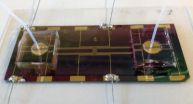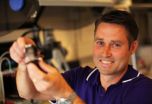(Press-News.org) Jerusalem, March 9, 2014 -- What if you could "hear" colors? Or shapes? These features are normally perceived visually, but using sensory substitution devices (SSDs) they can now be conveyed to the brain noninvasively through other senses.
At the Center for Human Perception and Cognition, headed by Prof. Amir Amedi of the Edmond and Lily Safra Center for Brain Sciences and the Institute for Medical Research Israel-Canada at the Hebrew University of Jerusalem Faculty of Medicine, the blind and visually impaired are being offered tools, via training with SSDs, to receive environmental visual information and interact with it in ways otherwise unimaginable. The work of Prof. Amedi and his colleagues is patented by Yissum, the Hebrew University's Technology Transfer Company
SSDs are non-invasive sensory aids that provide visual information to the blind via their existing senses. For example, using a visual-to-auditory SSD in a clinical or everyday setting, users wear a miniature camera connected to a small computer (or smart phone) and stereo headphones. The images are converted into "soundscapes," using a predictable algorithm, allowing the user to listen to and then interpret the visual information coming from the camera.
With the EyeMusic SSD (available free at the Apple App store at http://tinyurl.com/oe8d4p4), one hears pleasant musical notes to convey information about colors, shapes and location of objects in the world.
Using this SSD equipment and a unique training program, the blind are able to achieve various complex. visual-linked abilities. In recent articles in Restorative Neurology and Neuroscience and Scientific Reports, blind and blindfolded-sighted users of the EyeMusic were shown to correctly perceive and interact with objects, such as recognizing different shapes and colors or reaching for a beverage (A live demonstration can be seen at http://youtu.be/r6bz1pOEJWg).
In another use of EyeMusic, it was shown that other fast and accurate movements can be guided by the EyeMusic and visuo-motor learning. In studies published in two prestigious scientific journals, Neuron and Current Biology, it was demonstrated that the blind can characterize sound-conveyed images into complex object categories (such as faces, houses and outdoor scenes, plus everyday objects) and could locate people's positions, identify facial expressions and read letters and words, (See YouTube channel http://www.youtube.com/amiramedilab for demonstrations.)
Despite these encouraging behavioral demonstrations, SSDs are currently not widely used by the blind population. However, in a recent review published in Neuroscience & Biobehavioral Reviews, the reasons that have prevented their adoption have changed for the better over the past few years. For instance, new technological advances enable SSDs to be much cheaper, much smaller and lighter, and they can run using a standard Smart phone. Additionally, new computerized training methods and environments boost training and performance.
The Hebrew University research has shown that contrary to the long-held conception of the cortex being divided into separate vision-processing areas, auditory areas, etc., new findings over the past decade demonstrate that many brain areas are characterized by their computational task, and can be activated using senses other than the one commonly used for this task, even for people who were never exposed to "original" sensory information at all (such as a person born blind that never saw one photon of light in his life).
When processing "visual' information" conveyed through SSD, it was shown by the researchers that congenitally blind people who learned to read by touch using the Braille script or through their ears with sensory substitution devices use the same areas in the visual cortex as those used by sighted readers. A recent example of this approach was just published in Current Biology, showing that blind subjects "see" body shapes via their ears using SSD equipment and training.
There is a whole network of regions in the human brain dedicated to processing and perceiving of body shapes, starting from the areas processing vision in the cortex, leading to the "Extrastriate Body Area," or EBA, and further connecting to multiple brain areas deciphering people's motion in space, their feelings and intents.
In tests with the blind, it was found that their EBA was functionally connected to the whole network of body-processing found in the sighted. This lends strength to the researchers' new theory of the brain as a sensory-independent task machine, rather than as a pure sensory (vision, audition, touch) machine.
"The human brain is more flexible than we thought," says Prof. Amedi. "These results give a lot of hope for the successful regaining of visual functions using cheap non-invasive SSDs or other invasive sight restoration approaches. They suggest that in the blind, brain areas have the potential to be 'awakened' to processing visual properties and tasks even after years or maybe even lifelong blindness, if the proper technologies and training approaches are used."
INFORMATION: END
Blind can 'hear' colors and shapes, show Hebrew U. researchers
2014-03-10
ELSE PRESS RELEASES FROM THIS DATE:
Biomolecular tweezers facilitate study of mechanical force effects on cells and proteins
2014-03-10
A new type of biomolecular tweezers could help researchers study how mechanical forces affect the biochemical activity of cells and proteins. The devices – too small to see without a microscope – use opposing magnetic and electrophoretic forces to precisely stretch the cells and molecules, holding them in position so that the activity of receptors and other biochemical activity can be studied.
Arrays of the tweezers could be combined to study multiple molecules and cells simultaneously, providing a high-throughput capability for assessing the effects of mechanical forces ...
These aren't the voids you're looking for
2014-03-10
Australian astronomers have shown galaxies in the vast empty regions of the Universe are actually aligned into delicate strings in research published today in the Monthly Notices of the Royal Astronomical Society.
A team of astronomers based at The University of Western Australia node of the International Centre for Radio Astronomy Research (ICRAR) has found short strings of faint galaxies in what were previously thought to be extremely empty parts of space.
The Universe is full of vast collections of galaxies that are arranged into an intricate web of clusters and ...
A tricky balancing act: Antibiotics versus the gut microbiota
2014-03-10
(March 10, 2014) Antibiotics are valuable, potentially life-saving tools that have significantly reduced human morbidity and mortality. Unfortunately, antibiotics may also have unintended consequences from their off-target effects that may increase the risk of many long-term conditions. Recent epidemiologic studies have detected a possible link between antibiotic use in childhood and weight gain1 — with disruption to the normal gut microbiota considered the most likely cause.
"Infancy is an important time in the development of the human microbiota and these studies provide ...
Feeding gut microbiota: Nutrition & probiotics are key factors for digestive health
2014-03-10
(March 10, 2014) A healthy and balanced diet, as well as probiotics, have been known to be helpful in preserving gastrointestinal health for quite a long time. But it is only recently that the underlying mechanisms have become somewhat clearer. A rapidly increasing body of knowledge promises to further clarify the effects of our daily food on the gut microbiota and to indicate more targeted applications of probiotics in the near future. This was one of the topics presented at the Gut Microbiota for Health World Summit in Miami, FL, USA. On March 8-9, 2014, internationally ...
Lower IQ in teen years increase risk of early-onset dementia
2014-03-10
Men who at the age of 18 years have poorer cardiovascular fitness and/or a lower IQ more often suffer from dementia before the age of 60. This is shown in a recent study encompassing more than one million Swedish men.
In several extensive studies, researchers at the Sahlgrenska Academy of Gothenburg University have previously analyzed Swedish men's conscription results and were able to show a correlation between cardiovascular fitness as a teenager and health problems in later life.
Increased risk for early-onset dementia
In their latest study, based on data from 1.1 ...
Healthy eating may reduce the risk of preterm delivery
2014-03-10
In the study, which was conducted by researchers from the University of Gothenburg, Sahlgrenska University Hospital and the Norwegian Institute of Public Health, the participants completed a scientifically evaluated questionnaire about what they had been eating and drinking since becoming pregnant.
The researchers also had access to information about the women's general lifestyle e.g. level of education, living conditions, income, weight, physical activity, smoking habits, alcohol consumption, number of children and medical factors such as history of preterm delivery.
15 ...
Computer system simulates the behavior of tax evaders
2014-03-10
Tax fraud is a very serious problem for society, especially in Spain, where tax evasion represents almost one-fourth of its Gross Domestic Product. On the one hand, evasion is a problem because it produces a loss in public resources, something which is especially difficult in a time of economic crisis with cutbacks in public funding; on the other hand, tax fraud damages the effectiveness of justice within the tax system, since not everyone is able to evade taxes equally, thus leading to injustices between small and large companies and between the self-employed and employees. ...
New sugar-test to reduce false-positive cancer diagnoses
2014-03-10
The world's most widespread test for ovarian cancer reports false-positives in 94 of 100 diagnosed cases. Now, chemists at the University of Copenhagen working with clinical researchers at University College London have developed a method able to halve the number of false-positives. When fully developed, the new test will spare a significant number of women from unnecessary worry and further testing. Furthermore, global health care providers stand to save substantial sums – just by including a test on a certain sugar molecule in tandem with the currently prevailing diagnostic ...
There is no beating the breathalyzer this St. Patrick's Day (video)
2014-03-10
WASHINGTON, March 10, 2014 — If you're having some drinks this St. Patrick's Day weekend, remember to have a designated driver, otherwise you may end up on the business end of a breathalyzer on the side of the road. If you think you can beat it, think again; chemistry will land you in cuffs. In the American Chemical Society's (ACS') latest Reactions video, we examine how your breath can get you busted when you've had too much to drink. The video is available here: http://youtu.be/rvVzlg26bCM
Subscribe to the series at Reactions YouTube, and follow us on Twitter @ACSreactions ...
Europe must improve its response to the threat of plant pests and diseases
2014-03-10
Potentially devastating plant pests and diseases are highlighted in a new report from EASAC, the European Academies' Science Advisory Council, the leading provider of independent scientific advice to Europe's policy-makers. In the detailed EU-wide study of emerging plant pests and diseases, EASAC describes their combined threat to crops and forests and wider ecosystems, with implications for human health. In economic terms, as admitted by the EU Commission, billions of euros could be at stake and the environmental impact may be irreversible. Prof. Anne Glover, Chief Scientific ...






